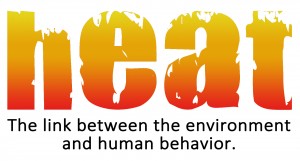Heat! It conjures up images of fire, rising temperatures, passion, even a movie. But it’s much more influential in our lives and something we often take for granted. Earth is in the “sweet spot” in its distance from the inferno of the Sun. Without the Sun’s heat, the temperatures on Earth would reach hundreds of degrees below zero and pretty soon life on earth would end. And should the Sun itself vanish, the gravity that held things together would instead allow all comets, asteroids and planets to fly off into space or each other.
While the scientific definition of heat is “the energy stored inside something” (like the core of the Earth), temperature is a measurement of how hot or cold something is. Things that are hot cool down (like a cup of coffee) and things that are cold get warmer (like a cup of ice cream.) How? Because heat travels and moves around and through objects. Then there’s weather, which is an atmospheric condition defined as temperatures of hot or cold, and environments that are sunny or rainy, for example. Weather is driven by air pressure, temperatures interacting with moisture, and the Sun’s angle relative to the axis of the Earth.
That’s heat in a nutshell. But why is it so important? Because weather shapes the Earth. And also because weather—with its temperature extremes of hot and cold—have an extraordinary impact on human health and well-being. In the northern hemisphere, August is a month synonymous with heat. The temperature is very hot. Wildfires abound. Sidewalks buckle in the heat. Some daring souls have fried eggs on their car bumpers during the month. August is also the “high season” for catastrophic hurricanes. Hurricane Katrina caused one million people to leave the Gulf Coast and move to other parts of the United States, becoming the largest diaspora in the history of the country.
The heat of August, coupled with high humidity, also contributes to exploding tempers and emotional outbursts.
Police reports show violent crimes soar in the hot months but less so in the cold months. Archaeologists and psychologists indicate there’s a link between the environment and human behavior. Evidence exists that extreme weather caused crop failures that led to unrest, uprising and the downfall of civilizations from Babylon to the Mayan Cultures to the dynasties of China.
Research scientists at UCLA Berkeley have been seeking a “grand unified theory of the environment and human behavior” that crosses location and time with the only constant being us. The research concludes that a degree of fluctuation from average temperatures or rainfall results in a predictable change in human conflict. They said this conflict plays out on New York subways, as well as at regional and national levels in the United States. When heat is brought into a discussion, it escalates tensions. For instance, when policemen were placed in a “heated simulator room” they were more likely to fire their guns when assaulted. In other words, heat in the environment appears to affect small-scale conflicts by escalating them into larger ones.
You’re probably wondering what this has to do with you personally. Sufi mystic Vilayat Inayat Khan suggests one should always
“Look for that which transpires behind that which appears” to get a better understanding of events.
What if there’s a correlation not just with the weather affecting humans but rather with humans affecting the weather? I don’t mean humans causing climate change, although that’s an aspect of it. Rather, what if the emotional state of humans is the actual cause of the weather we experience? What if the angry and fearful behavior of humans causes the disturbances in the weather?
We’re living in a violent period of Earth history. Civil discourse and respect for one another has taken a backseat. It’s evident in how we treat each other, the litter we leave on beaches and parks, and the value we place on the self and personal gain. If an argument in a heated moment can poison the atmosphere between friends so powerfully that it’s felt when others come into contact with them, then doesn’t it seems logical that this contaminated atmosphere also will radiate out as part of the weather? Enough heated arguments will create disastrous storms because our personal “atmosphere” is uniquely part of the global weather atmosphere.
When Pir Vilayat said “look for that which transpires behind that which appears” that phrase becomes a directive for each of us to carefully observe our actions and make a determination on how we’re influencing others. We are not alone in this! Not matter what we think to the contrary, we’re interconnected as one being.
What happens to one of us happens to the whole, especially when it’s simmered in Heat!
Jo Mooy has studied with many spiritual traditions over the past 40 years. The wide diversity of this training allows her to develop spiritual seminars and retreats that explore inspirational concepts, give purpose and guidance to students, and present esoteric teachings in an understandable manner. Along with Patricia Cockerill, she has guided the Women’s Meditation Circle since January 2006 where it has been honored for five years in a row as the “Favorite Meditation” group in Sarasota, FL, by Natural Awakenings Magazine. Teaching and using Sound as a retreat healing practice, Jo was certified as a Sound Healer through Jonathan Goldman’s Sound Healing Association. She writes and publishes a monthly internationally distributed e-newsletter called Spiritual Connections and is a staff writer for Spirit of Maat magazine in Sedona. For more information go to www.starsoundings.com or email jomooy@gmail.com.

